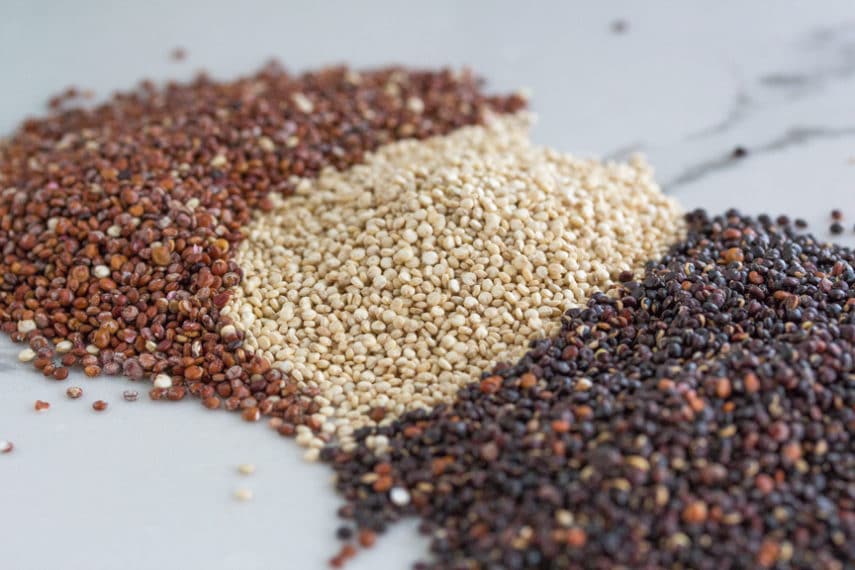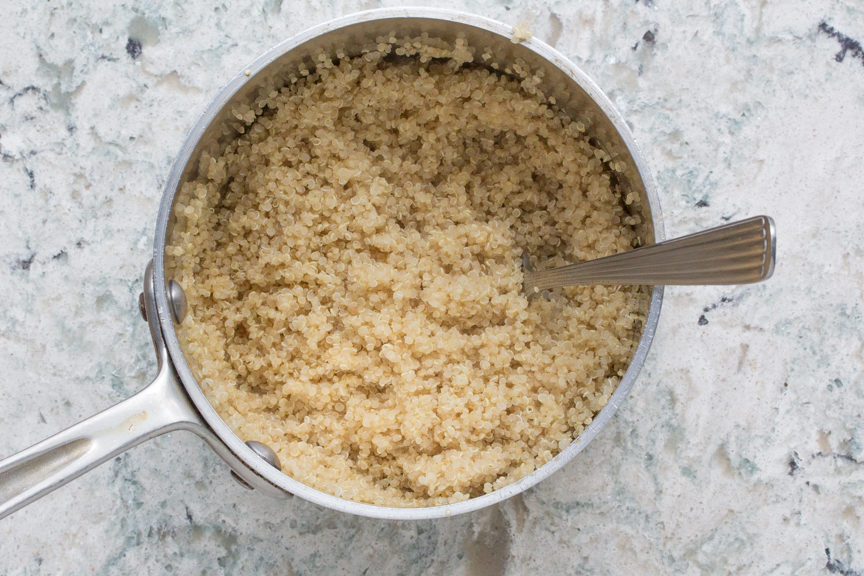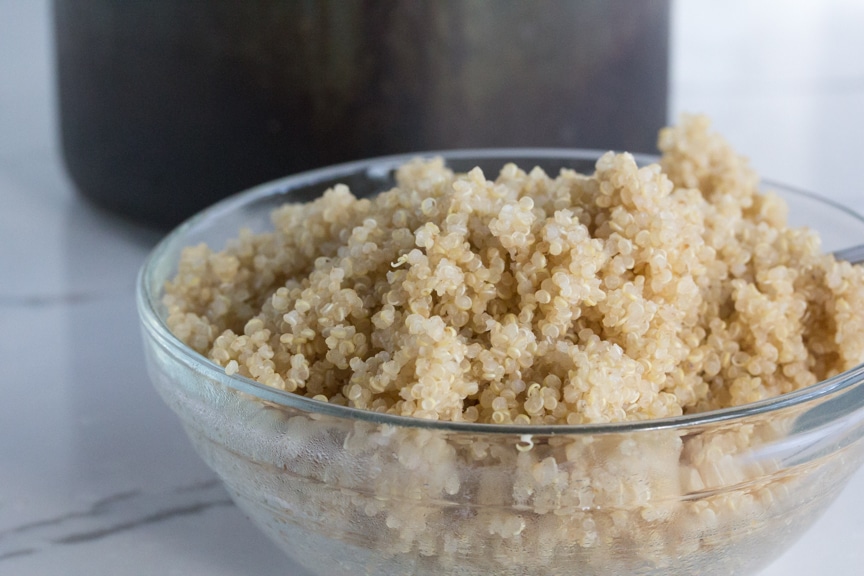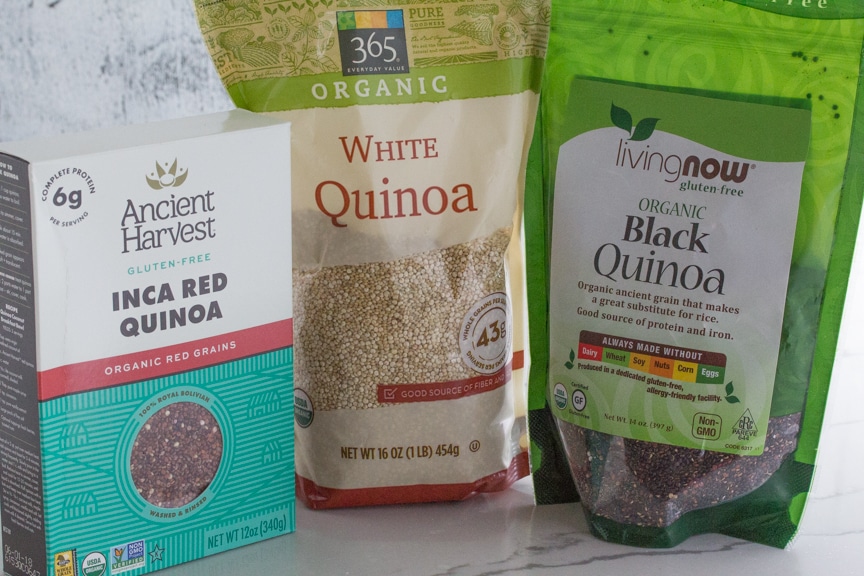About Quinoa
Is quinoa low FODMAP? Yes it is! Jump down to the section on Quinoa & FODMAPs for the details.
Chenopodium quinoa. Quinoa, pronounced Keen-wah, is a flowering plant that is closely related to spinach, amaranth and beets. Like amaranth, we treat the dried seed as a grain and cook it in a similar way to rice. In is actually sometimes referred to as a “pseudo-cereal”. The home cook can find white (the most common) as well as black and red Varieties (read more below). Quinoa is a gluten free, low FODMAP approved “grain”, suitable for the Elimination Phase.

Quinoa & FODMAPs
Several kinds of quinoa have ben lab tested. In addition to the whole grain black, red and white, quinoa flakes, pasta and flour all have low FODMAP serving sizes.
Quinoa
Black, Red & White Quinoa:
- Monash University recommends 1 cup (155 g) of cooked quinoa as one low FODMAP serving.
- FODMAP Friendly gives ½ cup cooked quinoa (75 g) a “Pass” as a low FODMAP serving size; a max serve size is 375 g.
Quinoa Flakes
Quinoa flakes are similar to rolled oats in that they are a whole grain that has turned into a flat, differently textured ingredient. We like Ancient Harvest brand. According to the company, the quinoa is baked and then turned into a flake with no added ingredients.
- Monash University suggested low FODMAP serving for quinoa flakes is 1 cup (45 to 50 g) uncooked. Become Moderate for FODMAPs at 120 g.
- FODMAP Friendly suggested low FODMAP serving for quinoa flakes is ½ cup (90 g) uncooked; max low FODMAP serve is 450 g.
Quinoa Pasta
- Monash has lab tested quinoa pasta and a suggested low FODMAP serving is 1 cup cooked, which equals 155 g.
- FODMAP Friendly lab tested suggested low FODMAP serving is 1 cup (155 g) cooked (even though the image shows uncooked). Max low FODMAP serve is 930 g.
Quinoa Flour
Quinoa flour is simply the dry grain that has been ground finely. Try it in our Quinoa Pancakes. We use Bob’s Red Mill brand.
- Monash University suggested low FODMAP serving for quinoa flour is 2/3 cup (100 g) flour.
- FODMAP Friendly suggested low FODMAP serving for quinoa flour is ½ cup (100 g); max low FODMAP serve is 700 g.

What Does Quinoa Taste Like?
Quinoa has a delicate taste that allows it to harmonize well with other foods, such as breakfast porridge with maple syrup, as a salad feature, or hot as a simple side dish. Some say it is a bit nutty or earthy; we think the white has the most delicate flavor, which we sometimes want and other times we want the more substantial flavor of the red, such as in a quinoa-based tabouli. The texture is similar to rice in that it resists a little to the tooth, with a softer, more yielding center. It can add a pleasant chewiness or slight crunch to dishes
Raw, it is coated with a bitter substance called saponin that must be removed prior to cooking. See How to Prep, below.
Once cooked, it becomes more translucent, which is most pronounced with the white variety. With any of the colors you will see a something that looks like a tiny “thread” once cooked, which is simply part of the hull that has broken down during cooking.

History & Nutrition
It originally hails from the Andes and was significant in providing nutrition to centuries of South American people – it is a complete protein, meaning that it contains the right balance of all the essential amino acids, something unusual for a plant based food. In fact the Incas referred to it as “the gold of the Incas” and “the mother grain” and there is historical evidence that domestication of the grain dates as far as 5,000 BC. It also contains a good amount of fiber, iron and zinc, per serving. The nutrition is virtually the same between the white, black and red types.
Bolivia is the main exporter; it was estimated the amount was 15,000 MT in 2010, and the U.S. is the major importer. France, the Netherlands, Germany, Canada, Israel, Brazil and UK follow in consumption.
Varieties
There are over 3,000 varieties or ecotypes of quinoa, some cultivated and some wild. There are 5 basic categories that are interestingly grouped into how and where they are grown: Quinoa from valleys; Quinoa from highlands; Quinoa from salt flats; Quinoa from sea level and Quinoa from subtropical zones.
From what we know of agricultural products, it stands to reason that different varieties, harvesting techniques, storage, etc. could yield different lab tests results, but since the low FODMAP servings are so generous, this is not much of a concern.
How to Buy
For us, the home consumer, we will typically have access to what we consider three types: white, red and black. It can be found in boxes alongside rice in many supermarkets and the most economical way to purchase is in bulk. The white variety tends to be less expensive than the black or red. We also find the black and red to cook up a tiny bit crunchier, and therefore the grains also remain a bit more separate. Sometimes you can also find blends of all three colors.
Whether buying in bulk or pre-packaged, check the label to see if it is “pre-washed”, which will save you a step. If it is not, see below.

How to Prep & Cook
Saponin is a natural bitter substance that coats the dry grains. In fact it protects the grains from being eaten from birds, so it has its reason for being.
If you or someone you know has tasted quinoa and found it quite unpalatable, it might have been because the saponin wasn’t rinsed off. This happened to Dédé the first time she tried it and subsequently she shied away from it for years!
This is easily remedied:
- Place dry quinoa in a mixing bowl and cover with cool water.
- Swish it around, then pour into a fine-meshed strainer and rinse further under cool running water.
- You can’t over-rinse it, so give it a good washing.
- Proceed with recipe.
Some recipes suggest soaking in water, but we have not found this to be necessary. This is a quick and easy grain to cook; no need to complicate things.
Here are some helpful details: 1 cup quinoa (170 g) dry, cooked with 2 cups (480 ml) of water, which will yield about 3 cups (720 ml) cooked.
How to Store
Store uncooked quinoa in an airtight container at room temperature. Once cooked it can be refrigerated in an airtight container for up to 4 days.

